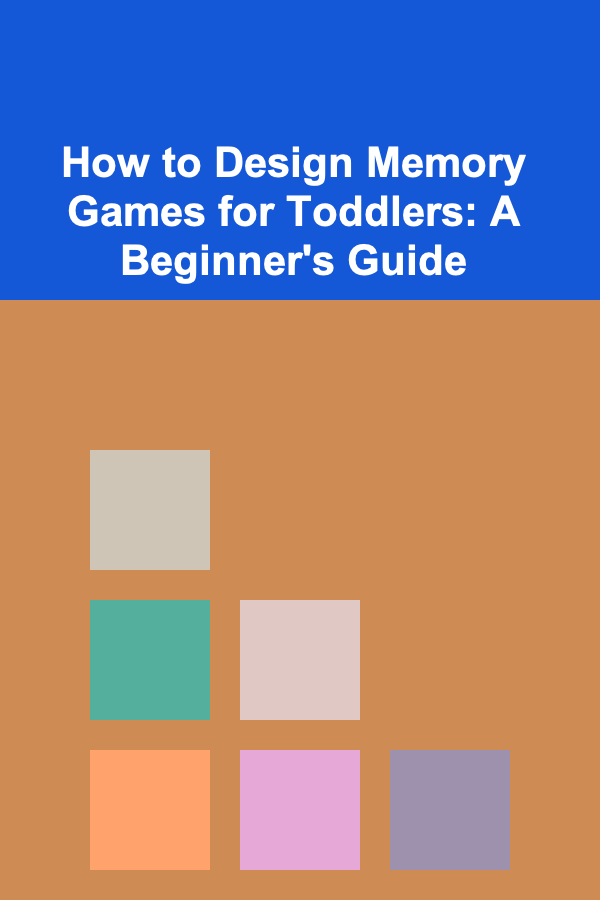
How to Design Memory Games for Toddlers: A Beginner's Guide
ebook include PDF & Audio bundle (Micro Guide)
$12.99$7.99
Limited Time Offer! Order within the next:

Designing memory games for toddlers is an exciting yet challenging task. At such a young age, children are still developing their cognitive abilities, so memory games need to be both fun and beneficial for their growth. Memory games help toddlers improve their focus, concentration, and recall skills, laying a foundation for future learning experiences.
In this guide, we will explore how to design effective memory games that are not only entertaining but also promote cognitive development in toddlers. We'll dive into the key principles, tips for game design, and strategies to ensure the games are both educational and enjoyable for young children.
Understanding Toddler Development
Before diving into the actual game design, it's important to understand toddler development. Toddlers, typically aged between 18 months and 3 years old, are still developing their motor skills, cognitive abilities, and language. Memory games for toddlers should take into account the following developmental factors:
Cognitive Development:
- Short Attention Span: Toddlers have short attention spans, usually ranging from 5 to 10 minutes. Games should be designed to be short and engaging, with simple instructions and easy-to-follow rules.
- Increasing Memory Capacity: While toddlers' memory capacity is still developing, they are beginning to improve their ability to remember and recognize patterns, colors, shapes, and objects.
- Basic Problem-Solving Skills: Toddlers are starting to understand cause and effect, which means that memory games should encourage them to think, explore, and make connections.
Motor Skills:
- Fine Motor Skills: At this age, toddlers are developing fine motor skills such as grasping and manipulating objects. Games should involve physical activities that encourage the use of hands, fingers, and coordination.
- Gross Motor Skills: Although less relevant in memory games, incorporating some movement into the design can help toddlers engage more actively in the game.
Social and Emotional Development:
- Learning Through Play: Toddlers learn a lot through play, and memory games offer a great opportunity for parents, caregivers, or peers to engage with them.
- Frustration Tolerance: At this age, toddlers are still learning how to handle frustration. Memory games should be easy enough to avoid excessive frustration but challenging enough to keep them engaged.
Language Skills:
- Vocabulary Development: Memory games can be used as a tool to expand vocabulary, especially when they feature pictures of animals, objects, or people.
Key Principles for Designing Memory Games for Toddlers
When designing memory games for toddlers, there are several key principles to keep in mind to ensure the game is developmentally appropriate and effective.
1. Keep It Simple
Simplicity is key. Memory games should have straightforward rules that toddlers can easily understand. Complicated instructions or concepts will confuse them and lead to frustration. For example, instead of playing a game where they need to match abstract symbols or letters, use familiar objects or animals that the child can recognize.
2. Focus on Familiar Objects
For toddlers, familiarity is crucial. Use objects, animals, or characters that the child already knows and recognizes. This could include common animals (like cats, dogs, or cows), household objects (such as balls or cups), or even familiar characters from their favorite cartoons. The more familiar the items are, the easier it will be for the child to connect them in their memory.
3. Limit the Number of Items
Toddlers have limited cognitive abilities, and too many objects to remember at once can overwhelm them. Start with a small number of items to match, ideally between 2 and 4. Gradually increase the number as the child becomes more proficient at remembering.
4. Use Bright, Colorful Visuals
Colorful and visually appealing designs grab a toddler's attention and make the game more engaging. Bold, bright colors help differentiate objects and make them easier to remember. Avoid overly complex designs, as these can distract or confuse toddlers.
5. Incorporate Movement
While memory games are traditionally about matching visual stimuli, incorporating movement into the game can enhance engagement. For example, if a child finds a match, encourage them to jump, clap, or make a sound. This physical activity helps toddlers stay engaged and can make the learning process more enjoyable.
6. Include Audio Cues
In addition to visual elements, sound can play an important role in memory games for toddlers. Audio cues, such as animal sounds or music, can reinforce memory retention. Positive reinforcement sounds like a "ding" or a cheer when they find a match can also make the game more rewarding.
7. Provide Positive Feedback
Toddlers thrive on positive feedback. After each successful match, offer verbal praise such as "Great job!" or "You did it!" This boosts their confidence and makes them feel encouraged to continue playing. Positive reinforcement helps toddlers stay motivated and engaged throughout the game.
Game Design Tips for Toddlers
With the principles outlined, here are a few design tips that will help you create effective and engaging memory games for toddlers:
Tip 1: Start with a Matching Game
A simple matching game is the best place to start. You can use cards with pictures of animals, objects, or even shapes. Lay the cards face down, and have the toddler turn over two cards at a time to find matching pairs. As the child gets better at matching, you can increase the number of cards or introduce more complex items.
Tip 2: Introduce a Shape and Color Matching Game
Toddlers are still learning about shapes and colors, so incorporating these elements into the memory game is a great way to teach them. For example, you can design a game where toddlers need to match red circles, blue squares, yellow triangles, and so on. This not only helps with memory but also teaches them basic shapes and colors.
Tip 3: Use a Storytelling Element
Memory games can be enhanced by incorporating storytelling elements. For example, you could create a game where each match reveals a part of a story. This makes the game more engaging and provides an additional opportunity for toddlers to recall and recognize elements of the narrative.
Tip 4: Introduce Animal Sounds
Create a memory game where toddlers match animals with their sounds. You can have pictures of animals on the cards, and when they flip a card, it could play the corresponding animal sound. This is a great way to combine memory recall with auditory recognition.
Tip 5: Use Interactive Technology
While traditional paper-based memory games are great, you can also use digital tools to design interactive games. Tablets or smartphones can be used to display images and sounds, creating an immersive experience. Just be sure to limit screen time and ensure that the game is not too complex for the child to navigate.
Tip 6: Focus on Consistency
Consistency helps toddlers understand the structure of the game. Keep the number of objects consistent in terms of color, shape, and design. This allows toddlers to focus on improving their memory without being distracted by varying elements.
Tip 7: Play Together
One of the best ways to design a successful memory game for toddlers is to play it together. Whether you're using cards or a digital game, playing together provides an opportunity for you to guide the toddler through the process, offer encouragement, and celebrate small successes.
Example Games for Toddlers
Here are a few examples of memory games that incorporate the design principles we've discussed:
1. Animal Memory Match
Create cards with pictures of common animals like a cat, dog, cow, and bird. The goal is for toddlers to turn over two cards at a time to find matching pairs of animals. As they find a match, they hear the corresponding animal sound.
2. Color and Shape Match
Create cards with different shapes and colors. For example, a red circle, blue square, yellow triangle, and green rectangle. The toddler's job is to match cards that are the same color or shape. This introduces both shapes and colors while challenging memory.
3. Storybook Memory
Create a memory game with pictures that correspond to a simple story. For example, a card with a sun, a card with a tree, and another with a bird. Each time the toddler finds a match, they reveal a piece of the story, creating a narrative that progresses as they play.
4. Sound and Object Match
Use cards that feature common objects, such as a ball, car, apple, and house. When the toddler finds a match, they hear a sound related to the object, such as a bouncing ball sound or a car horn.
Conclusion
Designing memory games for toddlers can be a rewarding experience for both you and the child. By focusing on simplicity, familiarity, and engaging elements like bright visuals, audio, and positive feedback, you can create games that not only help toddlers improve their memory but also enhance their cognitive development. Remember to keep the games fun and interactive, and always consider the developmental stage of the child to ensure that they are both challenged and encouraged.
Reading More From Our Other Websites
- [Organization Tip 101] How to Find Inspiration for Minimalist Living
- [Personal Investment 101] How to Invest in Royalties (Music, Patents, etc.) for Maximum Returns
- [Organization Tip 101] How to Create an Organized Entryway for a Clutter-Free Home
- [Personal Care Tips 101] How to Make an Affordable Facial Scrub with Simple Ingredients
- [Weaving Tip 101] Texture Tricks: Using Crochet Stitches to Elevate Hand-Woven Fabrics
- [Organization Tip 101] How to Maximize Space in a Small Home for Pet Supplies
- [Personal Investment 101] Make Money from Deep Learning by Creating AI-based Online Courses
- [Personal Care Tips 101] How to Lose Weight with a Plant-Based Diet
- [Personal Financial Planning 101] How to Create a Personal Financial Plan When You Feel Completely Overwhelmed
- [Mindful Eating Tip 101] How to Teach Mindful Eating Skills to Children with Autism Spectrum Disorder

How to Assess Your Risk Tolerance Before Investing
Read More
How to Clean and Organize Your Home Office Efficiently
Read More
How to Create a Cozy and Inviting Atmosphere Through Staging
Read More
How to Store Your Belongings Efficiently in a Small Closet
Read More
Mastering Freestyle Rollerblading: A Comprehensive Guide
Read More
Decoding the Brew: A Comprehensive Guide to Craft Beer Terminology
Read MoreOther Products

How to Assess Your Risk Tolerance Before Investing
Read More
How to Clean and Organize Your Home Office Efficiently
Read More
How to Create a Cozy and Inviting Atmosphere Through Staging
Read More
How to Store Your Belongings Efficiently in a Small Closet
Read More
Mastering Freestyle Rollerblading: A Comprehensive Guide
Read More